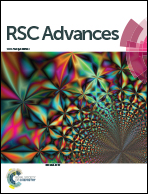Multicolor luminescent hybrid assembled materials based on lanthanide-containing polyoxometalates free from energy transfer crosstalk†
Abstract
A series of multicolor luminescent hybrid materials based on three primary molecular pixel components, isostructural lanthanide-containing inorganic clusters LnW10, i.e. red-emissive Na9EuW10O36 (EuW10) and green-emissive Na9TbW10O36 (TbW10), and a blue-emissive small organic molecule quinine were constructed in a general and straightforward way. The neutral-cationic block copolymer poly(ethylene oxide)114-b-poly(2-(2-guanidinoethoxy)ethyl methacrylate)23 (PEO114-b-PGu23) electrostatically co-assembles with the inorganic clusters LnW10 into micelles, and consequently effectively prohibits the energy transfer between LnW10 and quinine. Three luminescent elements possessing independent emission properties in supramolecular assemblies, like molecular pixels, were deeply investigated for the first time. On the basis of additive color theory, fluent emitting color changes within the triangle enclosed by the luminophores in the chromatic diagram were achieved at diverse mixing ratios and exciting wavelengths with precise prediction and convenient reproduction.


 Please wait while we load your content...
Please wait while we load your content...